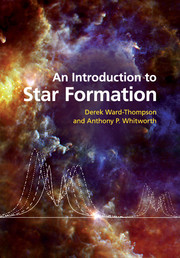Book contents
- Frontmatter
- Contents
- List of Illustrations
- Preface
- 1 Introduction
- 2 Probing star formation
- 3 The ISM – the beginnings of star formation
- 4 Molecular clouds – the sites of star formation
- 5 Fragmentation and collapse – the road to star formation
- 6 Young stars, protostars and accretion – building a typical star
- 7 The formation of high-mass stars, and their surroundings
- 8 By-products and consequences of star formation
- List of mathematical symbols
- List of figure credits
- Index
- References
5 - Fragmentation and collapse – the road to star formation
Published online by Cambridge University Press: 05 June 2012
- Frontmatter
- Contents
- List of Illustrations
- Preface
- 1 Introduction
- 2 Probing star formation
- 3 The ISM – the beginnings of star formation
- 4 Molecular clouds – the sites of star formation
- 5 Fragmentation and collapse – the road to star formation
- 6 Young stars, protostars and accretion – building a typical star
- 7 The formation of high-mass stars, and their surroundings
- 8 By-products and consequences of star formation
- List of mathematical symbols
- List of figure credits
- Index
- References
Summary
The road to star formation
Thus far we have studied the places where stars form – molecular clouds. We have discussed the ways in which molecular clouds can be observed. We have explored the various constituents of molecular clouds – gas, dust, magnetic fields, cosmic rays and electromagnetic radiation. We have, so to speak, assembled the ingredients. In this chapter we discuss how these ingredients might come together to begin to form a star.
In the first half of the chapter we discuss theoretical considerations. We consider the collapse of an isothermal sphere of gas, ignoring the effects of rotation and magnetic fields, and we examine qualitatively what happens. We describe the method of solving the problem using similarity solutions.
We go on to discuss hierarchical fragmentation, as a means of breaking a large molecular cloud into an ensemble of stars. We also discuss the thermodynamics of protostellar gas, and explain how the minimum mass for star formation might be determined by the protostellar gas becoming optically thick to its own cooling radiation. We discuss the manner of the collapse to form a star and the possible effects of a magnetic field on this process.
In the second half of the chapter we examine some of the observational evidence. At the end we consider the initial mass function for stars. Note that in this chapter we concentrate mainly on relatively low-mass stars, i.e. stars of less than a few times the mass of the Sun. In Chapter 6 we continue to discuss relatively low-mass star formation.
- Type
- Chapter
- Information
- An Introduction to Star Formation , pp. 95 - 116Publisher: Cambridge University PressPrint publication year: 2011

